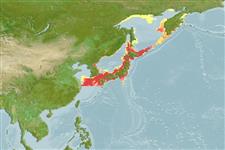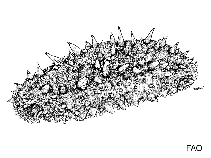Apostichopus japonicus (Selenka, 1867)
Japanese sea cucumber| Native range | All suitable habitat | Point map | Year 2050 |

|
| This map was computer-generated and has not yet been reviewed. |
| Apostichopus japonicus AquaMaps Data sources: GBIF OBIS |
Classification / Names Tên thường gặp | Các synonym ( Các tên trùng) | CoL | ITIS | WoRMS
Holothuroidea | Synallactida | Stichopodidae
Environment: milieu / climate zone / Mức độ sâu / distribution range Sinh thái học
; Mức độ sâu 0 - 200 m (Tài liệu tham khảo 635), usually 50 - 100 m (Tài liệu tham khảo 635). Subtropical; ? - 30°C (Tài liệu tham khảo 77134), preferred 16°C (Tài liệu tham khảo 107945); 63°N - 31°N, 117°E - 165°E (Tài liệu tham khảo 112755)
Distribution Các nước | Các khu vực của FAO | Các hệ sinh thái | Những lần xuất hiện | Những chỉ dẫn
Northwest Pacific: Japan (from Hokkaido to Kyushu), China, Korean Peninsula and Far Eastern Russia (Karaginskogo Island).
Length at first maturity / Bộ gần gũi / Weight / Age
Chín muồi sinh dục: Lm ?, range 20 - ? cm Max length : 30.0 cm TL con đực/không giới tính; (Tài liệu tham khảo 101467)
Life cycle and mating behavior Chín muồi sinh dục | Sự tái sinh sản | Đẻ trứng | Eggs | Sự sinh sản | Larvae
Main reference
Các tài liệu tham khảo | Người điều phối | Người cộng tác
Kan-no, M. and A. Kijima 2003 Genetic differentiation among three color variants of Japanese sea cucumber Stichopus jamponicus. Fisheries Science 69:806-812. (Tài liệu tham khảo 77132)
IUCN Red List Status
(Tài liệu tham khảo 130435: Version 2025-1)
CITES status (Tài liệu tham khảo 108899)
CMS (Tài liệu tham khảo 116361)
Threat to humans
Human uses
Các nghề cá: Tính thương mại; Nuôi trồng thủy sản: Tính thương mại
FAO - Nuôi trồng thủy sản: production, species profile; Các nghề cá: landings | FishSource | Biển chung quanh ta
Các công cụ
Thêm thông tin
Max. ages / sizes
Length-weight rel.
Length-length rel.
Length-frequencies
Mass conversion
Sự phong phú
Các nguồn internet
BHL | BOLD Systems | CISTI | DiscoverLife | FAO(Nuôi trồng thủy sản: species profile; Các nghề cá: ; publication : search) | Fishipedia | GenBank (genome, nucleotide) | GloBI | Gomexsi | Google Books | Google Scholar | Google | PubMed | Cây Đời sống | Wikipedia (Go, tìm) | Tạp chí Zoological Record



